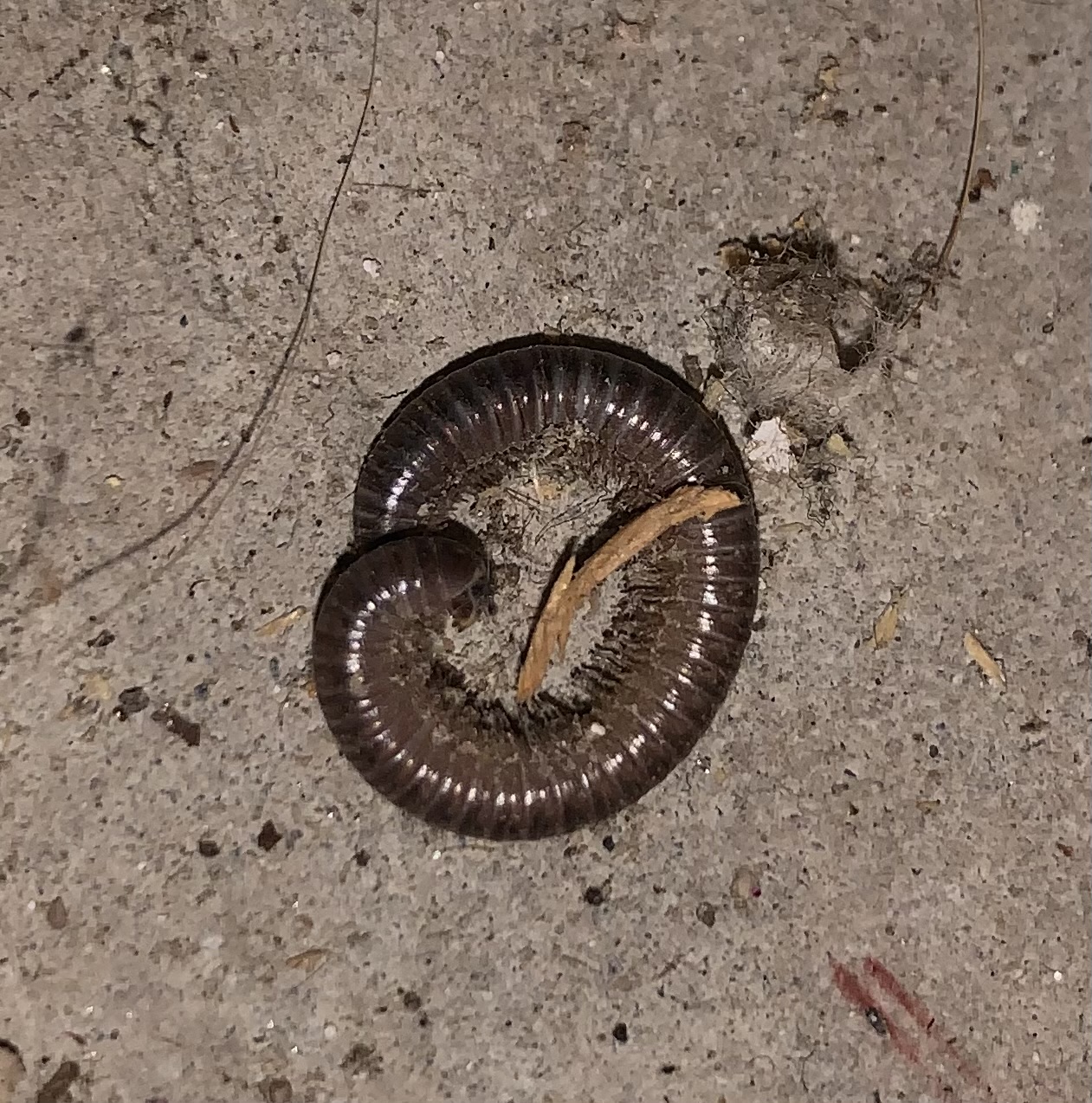Imagine that you had 50 pairs of legs. Not two legs like a human, not four legs like a dog, or six legs like an insect, and not eight legs like a spider, but one hundred. When you move, a ripple runs along them, propelling you forward in search of the same things all creatures need—food, shelter, and a mate. Once in a while those legs carry you into places you didn’t mean to go, like underneath my basement sink. People would call you a millipede in honor of all those legs. You don’t have a thousand as the name implies, but a hundred is quite enough! You startle people when they find you motating slowly along on the basement floor. You’re harmless, though, except for the nasty-smelling stuff you exude when you’re frightened or threatened. Okay, you’re not a millipede, but wouldn’t it be amazing to be one for, oh, half an hour?
The millipede under the sink lost its way, dried out, curled up and died. His ancestors, though, are thought to have been some of the first (probably lost?) creatures who crawled out of the ocean onto land over 400 million years ago. The oldest fossils date to somewhere in that time range. Today, millipedes can be found on every continent, and an individual can live for up to eleven years in the wild.
For being such an ancient and primitive race, the millipedes we see are actually pretty interesting. Some people even keep them as pets. Millipedes strongly prefer to live outside, under brush, dead logs, bark, dead leaves or other moist places with decaying matter. They are part of the natural cleanup squad that keeps life cycling instead of building up trash. They’re particularly important in recycling calcium and stimulating microbial activity.
Throughout the world, over 10,000 species of millipedes have been identified. In North America, as many as 1,400 species are busy cleaning up trash. They are not worms or insects or spiders. They are in a class of their own called diplopodia. The name refers to the fact that they have two pairs of legs attached to each segment of their bodies.
Although some are much larger, the ones I’m likely to find in the yard or basement are an inch to an inch and a half long. Their dark brown bodies are divided into two parts—a head and a trunk. The head has two antennae that they use for feeling their way, smelling and tasting things, measuring temperature and humidity, and finding water. They have eyes, but they are limited to light and motion detection. They need to breathe, but they don’t have noses. Instead, they have holes along the length of their bodies called spiracles. They “breathe” by drawing air in and sending the oxygen directly to the organs. They have a mouth with mandibles which they use to chew food before it passes into the digestive system.
The trunk of the millipede is a long, segmented tube. Each segment has spiracles and two pairs of legs. It also has a hard exoskeleton with “armor plates” on the back of each segment.
Millipedes like dark moist places and can quickly dig themselves into a burrow. They excavate the dirt and move the dirt by passing it along their legs and depositing it behind them. Small mammals, some ants, beetles, birds, salamanders and other animals would like to eat them.
To defend themselves, North American millipedes, like most species, have stink glands that they can employ when threatened. They produce a noxious substance that can burn your skin and eyes on contact. Their first line of defense, though, is to curl up with their hard exoskeletons on the outside and their softer undersides protected. They don’t bite or sting, and they don’t do any damage to wood or clothing or anything else except perhaps to sometimes get overly ambitious in a garden.
When millipedes mate, the male puts those many legs to work giving the female a back rub. He walks along her back, relaxing her. If she accepts him, he deposits sperm packets which she can reserve for future fertilization. She will seek out an outdoor nursery where its dark and damp, and in some species, she will lay one egg and curl up around it to incubate and protect it. Other species lay multiple eggs–up to 300 at a time in some cases. The hatchlings look like a shorter version of their elders and will grow through multiple molts adding more segments and legs each time. This process may take as much as a year to complete.
We haven’t seen any other millipedes in the basement, but I’m sure we have plenty of habitat for them outside. We’ll let them continue their jobs cleaning up and recycling. After all, they’ve been at it, helping keep the planet clean for over 400 million years.
Photo by Author

2 comments
Super interesting, thank you!